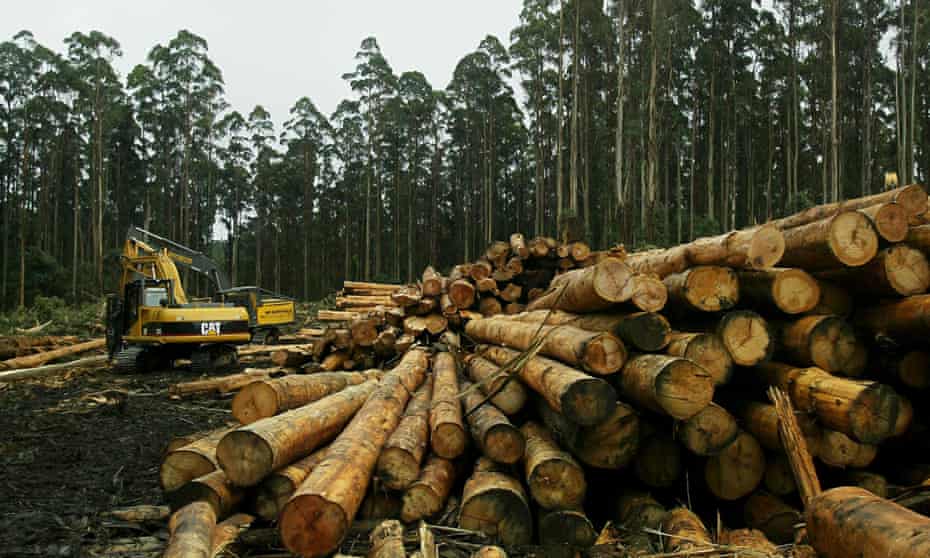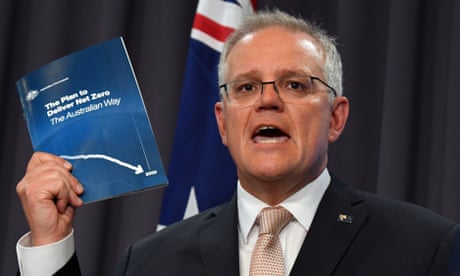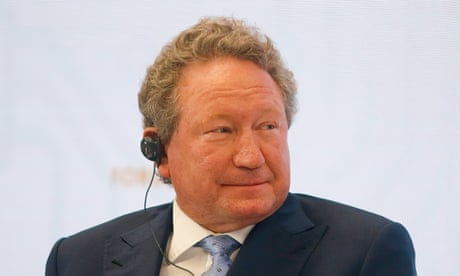AUSTRALIA
‘A farce’: experts dismiss government claims a controversial and unproven technology will cut emissions by 15%
Burning vegetation and injecting emissions underground ‘ecologically risky’ and ‘should be avoided’

Burning vegetation and injecting emissions underground ‘ecologically risky’ and ‘should be avoided’

Researchers have dismissed the Morrison government’s use of bioenergy with carbon capture and storage technology in its net zero emissions 2050 modelling.
Photograph: The AGE/Fairfax Media
Supported by
.png)
Graham Readfearn
@readfearn
Thu 18 Nov 2021 16.30 GMT
Experts have questioned how a controversial energy technology that doesn’t currently exist in Australia could be earmarked as a major source of cuts to greenhouse gas emissions in the Morrison government’s plan to reach net zero by 2050.
According to the government’s modelling report of its “technology not taxes” plan, a technique known as BECCS – bioenergy with carbon capture and storage – would be removing about 15% from the nation’s gross greenhouse gas emissions by 2050.
But the approach, which involves burning vegetation or waste for power and then capturing the carbon dioxide and injecting it underground, is not one of the priority technologies the government has picked to support.
The government’s modelling report has already come under fire from experts for questionable assumptions and an approach which leaves the gas industry to grow while relying on international offsets.
Experts said it was not clear how the government had arrived at the BECCS figure, with some saying the technique itself was unproven, problematic and ecologically risky.
Does Angus Taylor’s projection of a 35% 2030 emissions cut really ‘support the Paris agreement’?
BECCS theoretically requires three key elements – the availability of biomass such as trees, vegetation or waste and land and water to grow it; a power plant to burn the biomass and capture the CO2; and then a geological formation underground close by where the CO2 could be injected.
There was no mention of BECCS in the government’s latest progress report on its low emissions technology plans, published earlier this month.
According to the government’s modelling report, BECCS removes 38m tonnes of CO2 by 2050 under its technology plan, compared to 253Mt of gross emissions from sectors including electricity, transport and agriculture.
Other scenarios modelled by the government include even higher levels of BECCS.
BECCS is included in many global efforts to map out routes for economies to reach net zero, but remains controversial because of its potential to compete for land and resources currently used to produce food.
Dr Kate Dooley, a researcher at the University of Melbourne and an expert on how land could be used to mitigate climate change, said based on the government’s numbers, about 14m hectares – or about 6% of all Australia’s agricultural land – would be needed to generate emissions reductions at that level.
She said: “BECCS is an unproven technology with significant land area requirements which at a global scale have been shown to pose tradeoffs and serious risks for resource use, biodiversity, and food security.”
Dooley said while Australia’s size meant there were good opportunities to cut emissions on land, much of this potential came in reducing clearing.
She added: “Risky unproven technologies such as BECCS should be avoided in favour of options with greater co-benefits.”

Morrison government’s carbon capture plan at crossroads as Coalition MPs raise opposition
Energy and climate change program director at the Grattan Institute, Tony Wood, said including BECCS in the government’s planning at all “would be problematic because the report says it’s based on an assumption the technology is not economically viable in absence of incentives.
“But there’s nothing in the report that describes what incentives would trigger such an investment. It’s imposed on the modelling without any justification, but it offsets a substantial amount of emissions.
“These are extraordinary numbers to have in a report without any justification of how this would work, how it would happen and what the costs would be.”
Tim Baxter, a senior researcher at the Climate Council, said the inclusion of BECCS in the government’s modelling was a “farce”.
“The pretence that BECCS will get off the ground at this scale in Australia without careful, intelligent planning is absurd,” he said.
Chief executive of Climate Analytics, Bill Hare, said BECCS will “likely work” but wasn’t yet proven at scale anywhere in the world.
There has been little research carried out into the potential for BECCS in Australia. One study, published in 2018, did suggest a potential 25Mt of CO2 could be stored a year by 2050 through BECCS.
Australia could become a net negative emissions economy. The technology already exists
Frank Jotzo
But the research, from the University of Melbourne, was based on sourcing waste biomass “to avoid the ecological uncertainties and social challenges of dedicated energy crops.”
A co-author of that study, Prof Peter Cook, who also consults to industry and government on carbon capture and storage (CCS), said he was not aware of any BECCS projects in Australia and only a small number overseas where government incentives were being provided.
He said a challenge of combining bioenergy with CCS – which is among the government’s priority technologies – is “you can’t do it everywhere, you need the right rocks or you have to pipe [the CO2] a long way.”
He said BECCS was feasible and was among several technologies that would be needed in the future to pull CO2 out of the atmosphere.
But he added: “But it’s much better if we stop putting CO2 in the atmosphere in the first place.”

Andrew Forrest criticises use of carbon capture and storage saying it fails ‘19 out of 20 times’
On Thursday, the Australian Renewable Energy Agency released a roadmap to show the growth potential for the bioenergy industry in Australia.
There was no mention of combining bioenergy with CCS. But the roadmap said growing the bioenergy industry could cut emissions, divert waste from landfill, and improve the nation’s fuel security.
Guardian Australia asked emissions reduction minister Angus Taylor how the emissions reductions from BECCS were calculated for the report, why it wasn’t a priority technology, and where the government thought the biomass would be sourced from.
A spokesperson for the minister said in a statement: “Consistent with other long term emissions modelling exercises, including work by the [International Energy Agency] and US, the [Global Trade and Environmental Model] includes BECCS.
“Analysis by McKinsey does not include BECCS and achieves a similar net emissions outcome to the GTEM model. This illustrates that there are a range of technologies that will contribute to Australia achieving net zero emissions by 2050.”
Supported by
.png)
Graham Readfearn
@readfearn
Thu 18 Nov 2021 16.30 GMT
Experts have questioned how a controversial energy technology that doesn’t currently exist in Australia could be earmarked as a major source of cuts to greenhouse gas emissions in the Morrison government’s plan to reach net zero by 2050.
According to the government’s modelling report of its “technology not taxes” plan, a technique known as BECCS – bioenergy with carbon capture and storage – would be removing about 15% from the nation’s gross greenhouse gas emissions by 2050.
But the approach, which involves burning vegetation or waste for power and then capturing the carbon dioxide and injecting it underground, is not one of the priority technologies the government has picked to support.
The government’s modelling report has already come under fire from experts for questionable assumptions and an approach which leaves the gas industry to grow while relying on international offsets.
Experts said it was not clear how the government had arrived at the BECCS figure, with some saying the technique itself was unproven, problematic and ecologically risky.
Does Angus Taylor’s projection of a 35% 2030 emissions cut really ‘support the Paris agreement’?
BECCS theoretically requires three key elements – the availability of biomass such as trees, vegetation or waste and land and water to grow it; a power plant to burn the biomass and capture the CO2; and then a geological formation underground close by where the CO2 could be injected.
There was no mention of BECCS in the government’s latest progress report on its low emissions technology plans, published earlier this month.
According to the government’s modelling report, BECCS removes 38m tonnes of CO2 by 2050 under its technology plan, compared to 253Mt of gross emissions from sectors including electricity, transport and agriculture.
Other scenarios modelled by the government include even higher levels of BECCS.
BECCS is included in many global efforts to map out routes for economies to reach net zero, but remains controversial because of its potential to compete for land and resources currently used to produce food.
Dr Kate Dooley, a researcher at the University of Melbourne and an expert on how land could be used to mitigate climate change, said based on the government’s numbers, about 14m hectares – or about 6% of all Australia’s agricultural land – would be needed to generate emissions reductions at that level.
She said: “BECCS is an unproven technology with significant land area requirements which at a global scale have been shown to pose tradeoffs and serious risks for resource use, biodiversity, and food security.”
Dooley said while Australia’s size meant there were good opportunities to cut emissions on land, much of this potential came in reducing clearing.
She added: “Risky unproven technologies such as BECCS should be avoided in favour of options with greater co-benefits.”

Morrison government’s carbon capture plan at crossroads as Coalition MPs raise opposition
Energy and climate change program director at the Grattan Institute, Tony Wood, said including BECCS in the government’s planning at all “would be problematic because the report says it’s based on an assumption the technology is not economically viable in absence of incentives.
“But there’s nothing in the report that describes what incentives would trigger such an investment. It’s imposed on the modelling without any justification, but it offsets a substantial amount of emissions.
“These are extraordinary numbers to have in a report without any justification of how this would work, how it would happen and what the costs would be.”
Tim Baxter, a senior researcher at the Climate Council, said the inclusion of BECCS in the government’s modelling was a “farce”.
“The pretence that BECCS will get off the ground at this scale in Australia without careful, intelligent planning is absurd,” he said.
Chief executive of Climate Analytics, Bill Hare, said BECCS will “likely work” but wasn’t yet proven at scale anywhere in the world.
There has been little research carried out into the potential for BECCS in Australia. One study, published in 2018, did suggest a potential 25Mt of CO2 could be stored a year by 2050 through BECCS.
Australia could become a net negative emissions economy. The technology already exists
Frank Jotzo
But the research, from the University of Melbourne, was based on sourcing waste biomass “to avoid the ecological uncertainties and social challenges of dedicated energy crops.”
A co-author of that study, Prof Peter Cook, who also consults to industry and government on carbon capture and storage (CCS), said he was not aware of any BECCS projects in Australia and only a small number overseas where government incentives were being provided.
He said a challenge of combining bioenergy with CCS – which is among the government’s priority technologies – is “you can’t do it everywhere, you need the right rocks or you have to pipe [the CO2] a long way.”
He said BECCS was feasible and was among several technologies that would be needed in the future to pull CO2 out of the atmosphere.
But he added: “But it’s much better if we stop putting CO2 in the atmosphere in the first place.”

Andrew Forrest criticises use of carbon capture and storage saying it fails ‘19 out of 20 times’
On Thursday, the Australian Renewable Energy Agency released a roadmap to show the growth potential for the bioenergy industry in Australia.
There was no mention of combining bioenergy with CCS. But the roadmap said growing the bioenergy industry could cut emissions, divert waste from landfill, and improve the nation’s fuel security.
Guardian Australia asked emissions reduction minister Angus Taylor how the emissions reductions from BECCS were calculated for the report, why it wasn’t a priority technology, and where the government thought the biomass would be sourced from.
A spokesperson for the minister said in a statement: “Consistent with other long term emissions modelling exercises, including work by the [International Energy Agency] and US, the [Global Trade and Environmental Model] includes BECCS.
“Analysis by McKinsey does not include BECCS and achieves a similar net emissions outcome to the GTEM model. This illustrates that there are a range of technologies that will contribute to Australia achieving net zero emissions by 2050.”
No comments:
Post a Comment